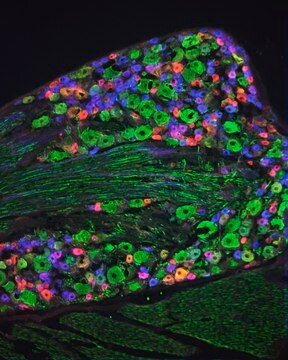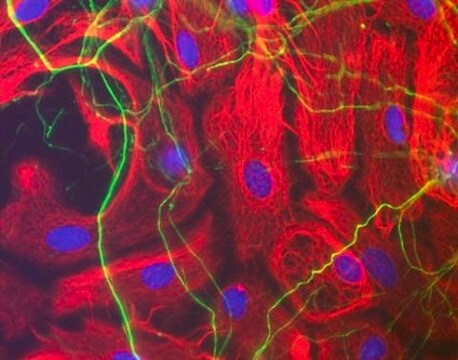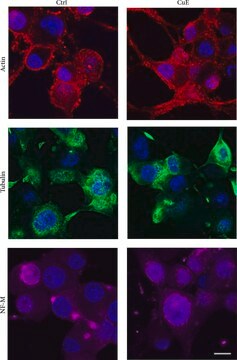SAB4200747
Anti-Neurofilament 200 antibody, Mouse monoclonal
clone NE14, purified from hybridoma cell culture
Synonym(e):
Anti-H-subunit, Anti-NF-H
About This Item
Empfohlene Produkte
Biologische Quelle
mouse
Qualitätsniveau
Antikörperform
purified from hybridoma cell culture
Antikörper-Produkttyp
primary antibodies
Klon
NE14, monoclonal
Form
buffered aqueous solution
Mol-Gew.
~200 kDa
Speziesreaktivität
feline, rat, guinea pig, pig, human, mouse, bovine, chicken
Konzentration
~1.0 mg/mL
Methode(n)
immunoblotting: 1.25-2.5 μg/mL using rat brain S1 fraction
immunohistochemistry: 5-10 μg/mL using enzyme treated formalin-fixed, paraffin-embedded rat brain or mouse brain sections
Isotyp
IgG1
UniProt-Hinterlegungsnummer
Versandbedingung
dry ice
Lagertemp.
−20°C
Posttranslationale Modifikation Target
unmodified
Angaben zum Gen
bovine ... Nefh(528842)
cat ... Nefh(101087272)
chicken ... Nefh(417020)
human ... NEFH(4744)
mouse ... Nefh(380684)
pig ... Nefh(100156492)
rat ... Nefh(24587)
Allgemeine Beschreibung
Immunogen
Anwendung
Biochem./physiol. Wirkung
Physikalische Form
Sie haben nicht das passende Produkt gefunden?
Probieren Sie unser Produkt-Auswahlhilfe. aus.
Lagerklassenschlüssel
10 - Combustible liquids
Flammpunkt (°F)
Not applicable
Flammpunkt (°C)
Not applicable
Analysenzertifikate (COA)
Suchen Sie nach Analysenzertifikate (COA), indem Sie die Lot-/Chargennummer des Produkts eingeben. Lot- und Chargennummern sind auf dem Produktetikett hinter den Wörtern ‘Lot’ oder ‘Batch’ (Lot oder Charge) zu finden.
Besitzen Sie dieses Produkt bereits?
In der Dokumentenbibliothek finden Sie die Dokumentation zu den Produkten, die Sie kürzlich erworben haben.
Kunden haben sich ebenfalls angesehen
Unser Team von Wissenschaftlern verfügt über Erfahrung in allen Forschungsbereichen einschließlich Life Science, Materialwissenschaften, chemischer Synthese, Chromatographie, Analytik und vielen mehr..
Setzen Sie sich mit dem technischen Dienst in Verbindung.








